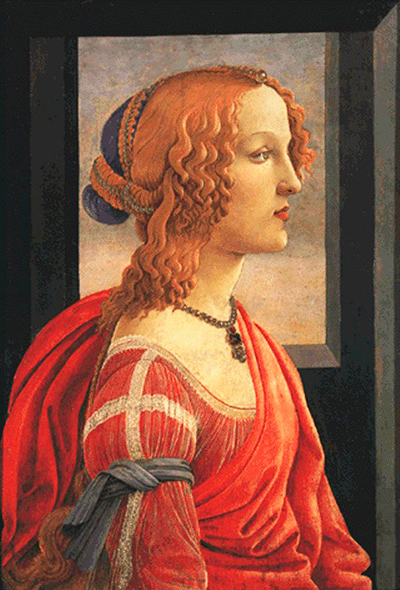Portrait of a Young Woman is one of Sandro Botticelli's most famous portraits. It depicts the beautiful Simonetta Vespucci who also appeared in a number of other paintings, including the one found here.
This portrait displays the young woman down to around her waist line, again focusing entirely on the model herself and leaving out any real detail from the rest of the composition. Botticelli was a true master of portraiture, but more commonly produced artworks with many different figures within them, often with themes of religion baked into each piece. Here the artist simply concentrates on making use of his ability to complement female beauty in a way that few other Renaissance artists could achieve. He dresses the model fairly simply, in an elegant but subtle manner which was in keeping for her status in Florence at the time. Many considered her to be the most beautiful woman in the Kingdom and so she would have been used to sitting for artists at this point, with even just Botticelli himself painted her on multiple occasions. The artist's lifelike depictions have also helped historians to learn more about the types of attire worn during this period in Italian history, many years before it would become a unified region.
Simonetta Vespucci is a slim young woman with beautifully styled hair. She sports some decorative elements around the back of her head and a delighful necklace, but is presented in a fairly subtle manner. Her clothing is elegant but fairly plain, with embroidered touches to her garments. A piece of cloth is tied around her right arm, perhaps as a symbolic addition by the artist. A red cape is then draped over her left shoulder and then presumably tied around her waist just below where this painting is cropped. A window can be found directly behind her, over her left shoulder and this allows the artist to implement some bright tones of colour, though he is careful to avoid giving the background any great detail so that the full focus of the viewer remains entirely on the model herself. He continued this technique in the other portraits that he produced of her.
Whilst being more than capable of producing these intimate portraits, Botticelli tended to prefer more ambitious content that also brought about some of his most famous paintings. See the likes of Birth of Venus, Primavera and Mars and Venus for examples of those. He happily allowed assistants to take on some of the more mundane elements of these paintings so that he could ultimately increase his output and take on more patrons as his career developed. He was very adept at full length portraits and could incorporate these into scenes of architecture or landscape, sometimes managing to combine all three. Often he was guided by religious scripture, though he always allowed himself some room for artistic license whilst broadly following a particular Christian story.




